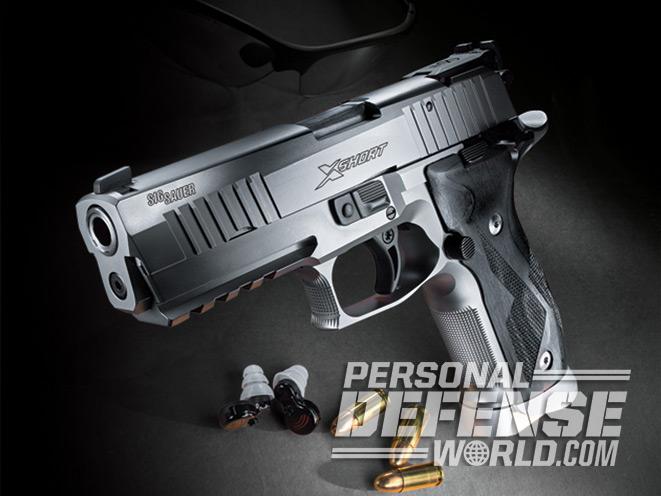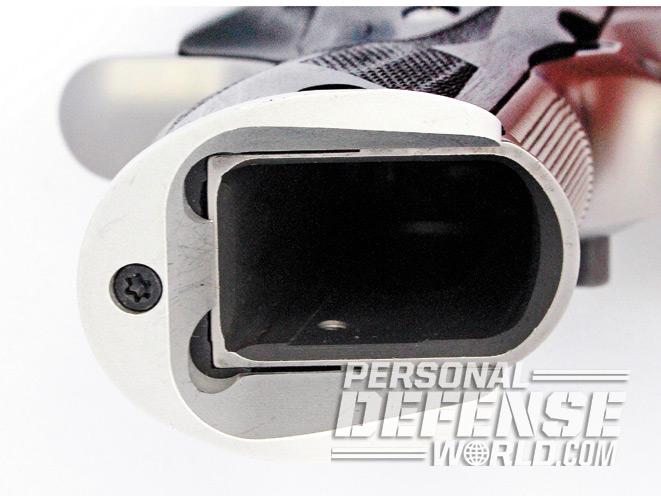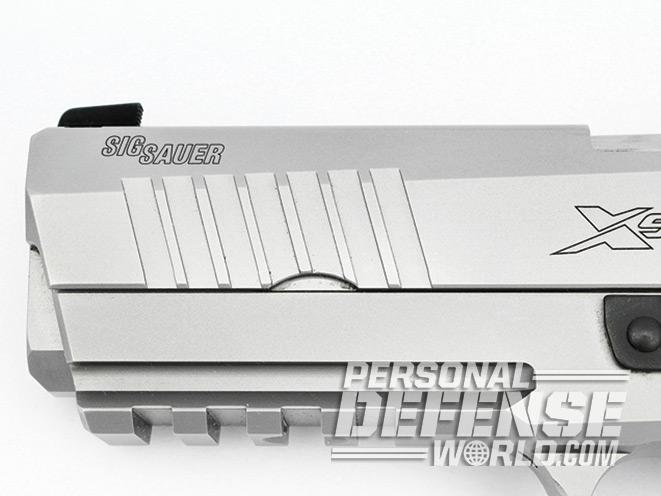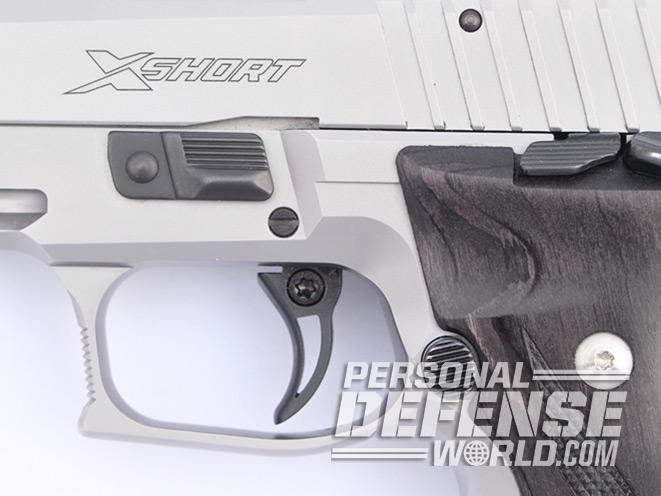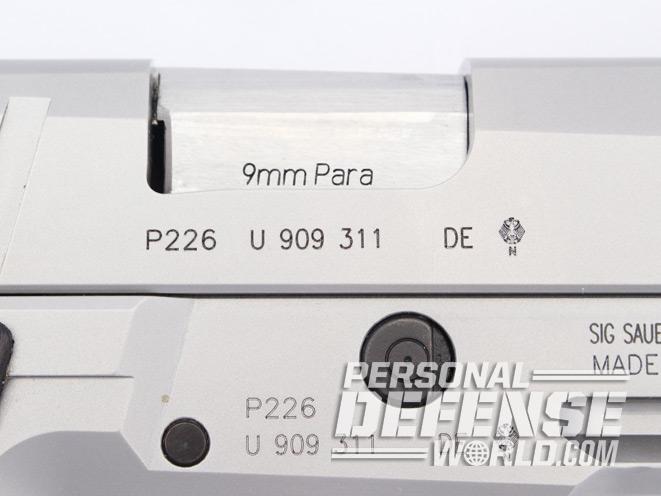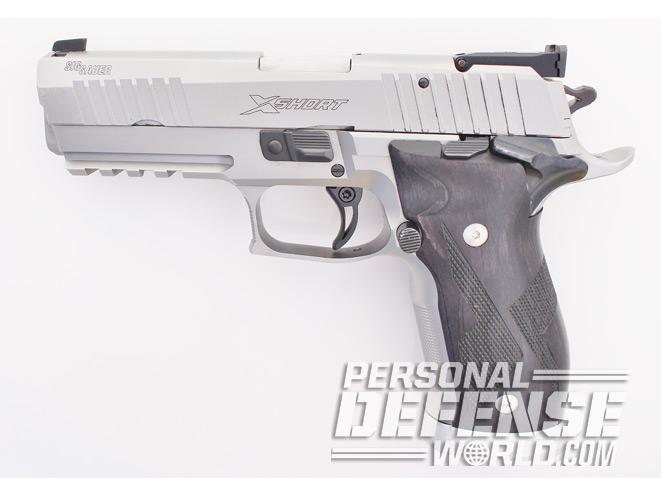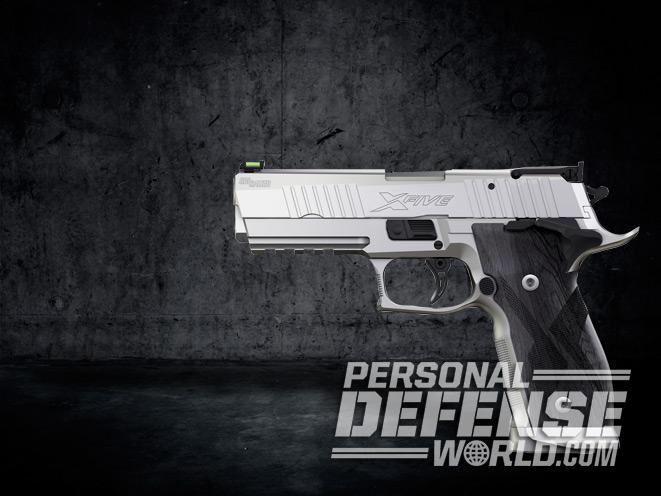Sig Sauer’s new X-Five pistols elevate the venerable P226 to a new level of performance. Even so, the X-Fives aren’t just another series of race guns. That’s especially true of the X-Five Short. With its handy 4.4-inch barrel, accessory rail, 19-shot magazine and fully adjustable single-action (SA) trigger, the X-Five Short is also a good choice for military special operations, SWAT team precision shooting and civilian home defense.
The X-Five Short has a number of features that make it ideal for fast and accurate shooting. The matte black color of its sights and operating controls offer an eye-catching contrast with its matte stainless finish. The striations on the rear surface of the fully adjustable rear sight and the rear of the front sight blade further reduce glare and enhance contrast. The 20 line-per-inch checkering on the front of the hooked triggerguard and the frame’s front grip strap are well executed and provide a solid hold. The grip is further enhanced by X-shaped checkering panels on the wraparound, laminated wood grip. The grip itself is contoured and fit my hand like a glove.
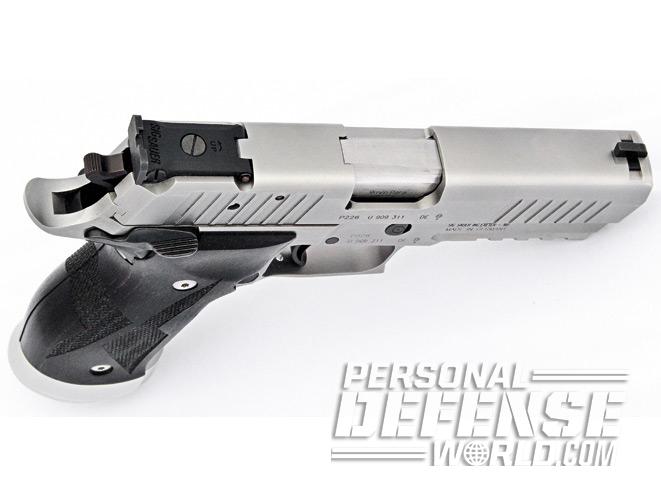
The controls and surfaces of the pistol are what one would expect in a gun intended for competition. All edges are “melted,” leaving no sharp corners or edges to cut the hand. The extended magazine release, takedown lever, slide release, hammer spur and ambidextrous safety are serrated, giving them a “no-slip” surface. The extended and flared magazine well is designed for ultra-fast and smooth feeding. The trigger precisely fits the first joint of the trigger finger, and it can be adjusted for pull weight, overtravel and clearance.
Advertisement — Continue Reading Below
With respect to workmanship, the fit of the barrel to the slide was tight and there were no external or internal tool marks or other flaws. There was no excess play between any of the parts, and the hammer could not be pushed off the full or half-cock positions. The two-stage trigger pull had about 0.375 inches of take-up and almost no overtravel. Pull weight was set at 3.5 pounds, which is the maximum pull for which the trigger can be adjusted. That’s definitely where I would leave it for both competition and self-defense. Overall, the pistol’s quality of manufacture is excellent.
Bench Test
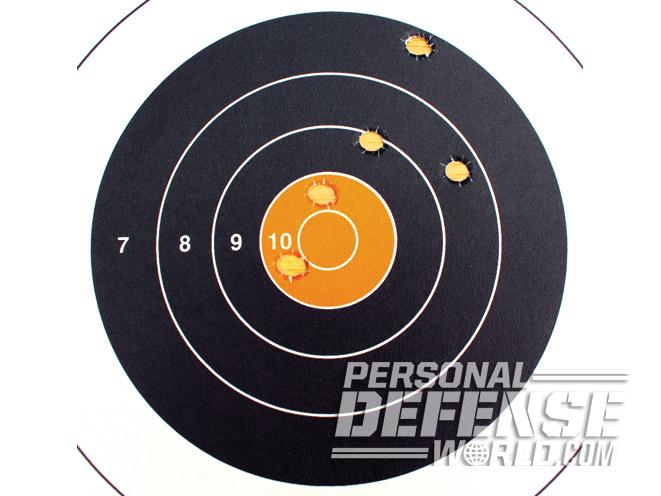
The X-Five Short was fired for accuracy and velocity with Black Hills’ 115-grain +P XTP HP, CorBon’s 115-grain DPX +P, Hornady’s Critical Defense 115-grain FTX and Freedom Munitions’ 147-grain HP load. Matches were fired using Winchester’s 147-grain Ranger SXT, 147-grain Train and 115-grain “White Box” ammunition. In addition, Federal’s 115-grain jacketed round nose (JRN) and American Eagle 124-grain JRN loads were also used in competition. I put a total of almost 500 rounds through the Sig Sauer P226 X-Five Short.
Advertisement — Continue Reading Below
RELATED: Sig Sauer P290RS – A Lightweight, .380 ACP Pocket Protector
Velocities produced by the X-Five Short’s 4.4-inch barrel were considerably faster than with other 9mm handguns that have barrels of similar lengths. The highest-velocity load tested was Black Hills’ +P, which is loaded with Hornady’s 115-grain XTP bullet. Average velocity was a very respectable 1,422 feet per second (fps), and average muzzle energy was 516 foot-pounds. That’s about halfway between the upper limit of .38 Super and the lower limit of 9x23mm Winchester! Despite this, functioning was perfect with this load. In addition, the weight of the X-Five Short’s all-steel construction and its well-designed grips made recoil quite tolerable. Performance with CorBon’s 115-grain DPX was also excellent with an average of 1,287 fps and 423 foot-pounds.
Accuracy testing at 25 yards produced average five-shot group results that were in the neighborhood of 3 inches for all loads, except the very high-velocity load from Black Hills which produced groups that averaged just over 4 inches. Higher-pressure handgun loads don’t always shoot the tightest groups. In addition, accuracy was probably affected by the shapes of the squared triggerguard and the accessory rail, which made it a bit difficult to rest the pistol on the pistol rest. Therefore, the 1.47-inch group contained in the factory-supplied test target was more representative of the accuracy potential of the X-Five Short. Certainly this pistol’s performance in competition demonstrated that it was not difficult to shoot it with precision using either a one- or two-handed hold.
Advertisement — Continue Reading Below
Competition Tests
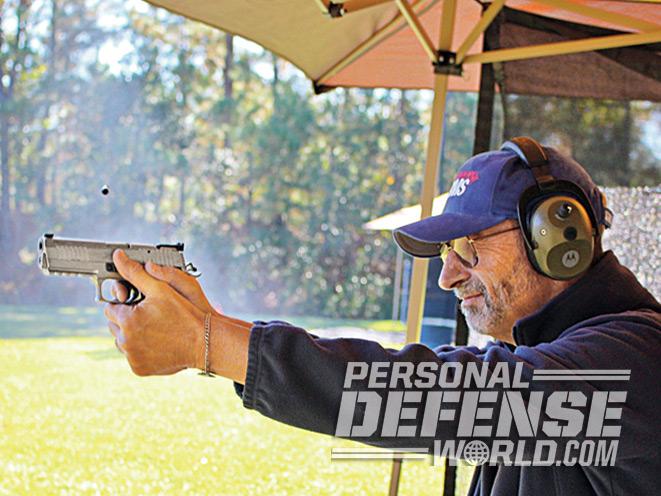
At 43.5 ounces, the all-steel X-Five Short is just a bit over the maximum weight for the International Defensive Pistol Association (IDPA) matches I usually shoot, but the pistol does meet all requirements for United States Practical Shooting Association (USPSA), Bullseye matches and Steel Challenge matches. I decided to shoot the X-Five Short at a USPSA match at the Volusia County Gun & Hunt Club, and also at the Flagler Gun & Archery Club’s weekly informal Bullseye and Steel Challenge matches.
RELATED: New For 2015 – Sig Sauer’s Ultra-Covert P320 Subcompact | VIDEO
Advertisement — Continue Reading Below
First up was Bullseye. This discipline has lost some popularity in recent years, but it’s still the best competition for practicing handgun fundamentals. Even though the X-Five Short isn’t a typical Bullseye pistol, I decided to shoot it in two matches at the Flagler Gun Club. In order to save a bit of ammo for other competitions, the X-Five Short was only shot in just the Centerfire portion of one Bullseye match and in an “Army-L” Bullseye match.
The pistol was fired strong-hand only, and magazines were loaded with five rounds, bringing the total weight of the pistol to about 46 ounces. The key to shooting Bullseye with this pistol was learning to use its two-stage trigger. By staging the trigger to the break point before pulling through, it was possible to get a very clean break. My best Centerfire match score at 25 yards was 89-1X in the timed-fire stage. My score on the Army L’s 15-yard, rapid-fire stage was 94-4X. Given my previous lack of familiarity with this pistol, these are decent scores.
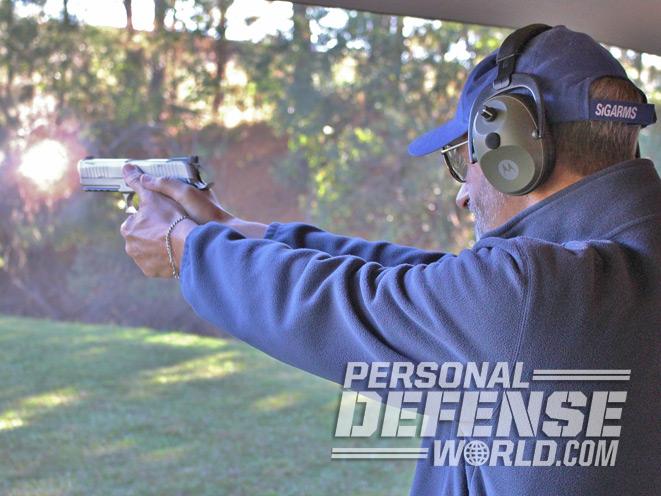
Advertisement — Continue Reading Below
USPSA was next. The X-Five Short’s 4.4-inch barrel points quickly and the pistol’s black adjustable sights show up very well on tan cardboard USPSA targets. The pistol’s weight and well-formed gripping surfaces helped control recoil in this speed-oriented discipline, and the X-Five Short’s SA trigger is light and consistent.
RELATED: New Sig Sauer Elite Performance Ammo | VIDEO
USPSA competition has very different rules than the IDPA matches I normally shoot. As a result, I lost time when I defaulted to my tactical training, extensively used cover and carefully pied corners instead of standing in the open and rapidly engaging multiple targets. On the other hand, my hits were very good.
Advertisement — Continue Reading Below
The final match was the weekly informal Steel Challenge. Shooting steel proved to be very enjoyable, as long as I remembered that the X-Five Short has a two-stage trigger and not a one-stage trigger like my 1911s. During the second half of the match things really began to come together and the best string was a fast 4.84 seconds. All shots on the five targets were within a 4-inch circle in the middle of the plate. Most of my runs on this half of the course were well under 6 seconds.
My overall times for the USPSA and Steel Challenge matches were hindered by a few stoppages that came when using standard-pressure ammo. This did not happen with any of the +P JHP ammo. European 9mm ammunition is often loaded to higher pressures than ammo produced in the U.S. Given this fact, the problem with the X-Five Short I tested could be solved by a simple tuning of the pistol’s internal extractor.
The Takeaway
Advertisement — Continue Reading Below
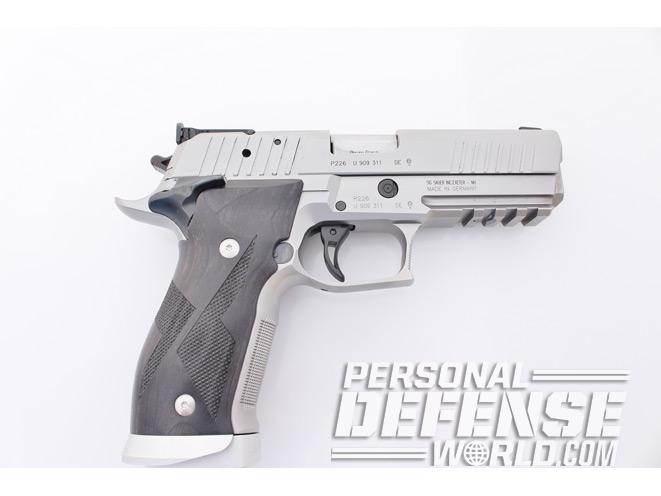
The P226 X-Five Short is a very high-quality firearm that’s suitable for a variety of shooting competitions and a number of tactical applications. With a little extractor tuning for complete reliability with American ammunition, the test gun could also be an excellent choice for law enforcement SWAT teams and civilian home defense.
For more information, visit http://www.sigsauer.com or call 866-345-6744.
Advertisement — Continue Reading Below
